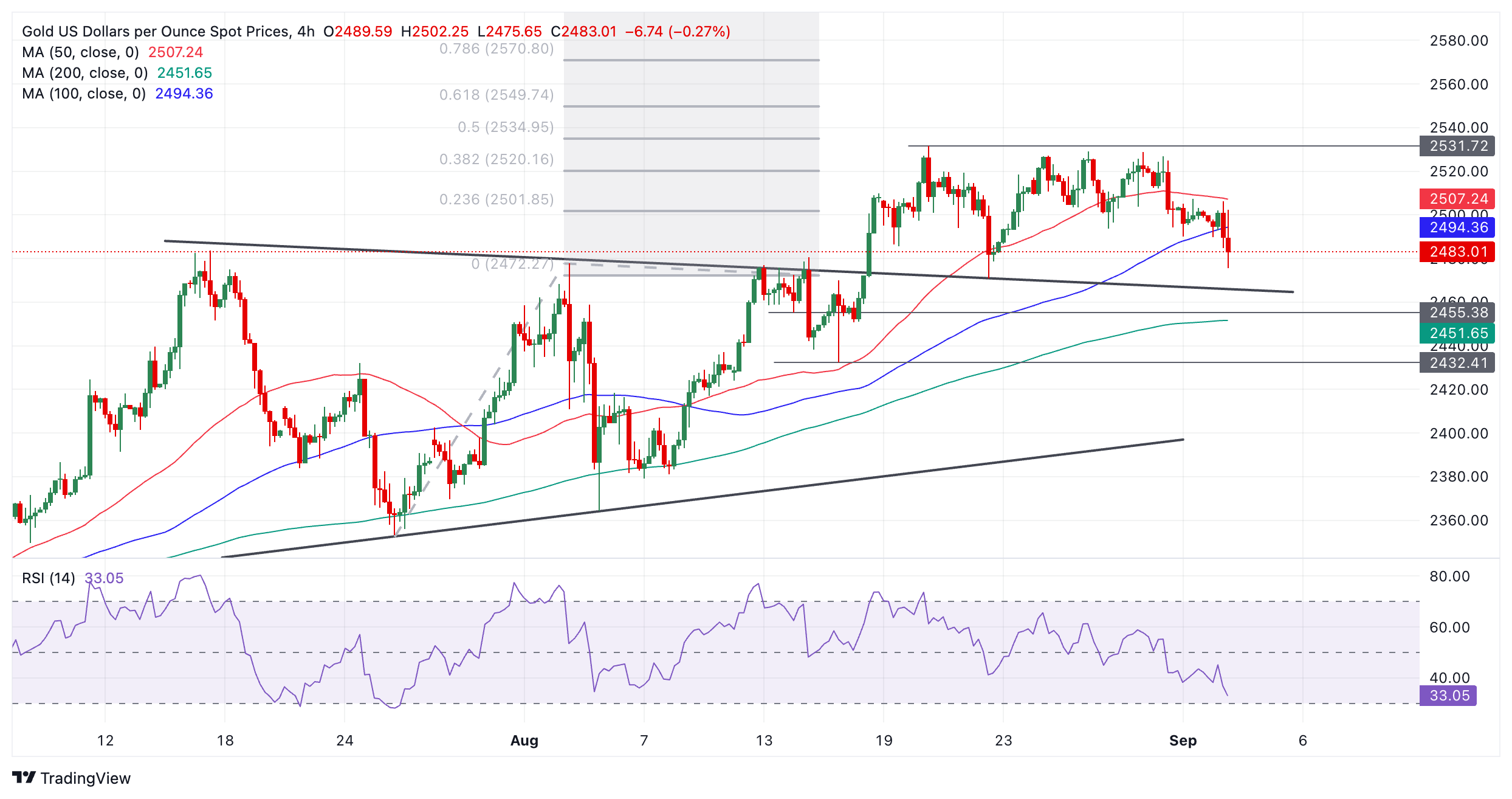- Gold trades breaks below $2,500 amid a financial-market wide sell-off.
- Traders await US labor market data this week which will help determine future course of interest rates.
- The break below $2,500 is key from a technical perspective as it threatens a bearish reversal.
Gold (XAU/USD) trades in the $2,480s on Tuesday on the back of a broad financial market sell-off that sees most commodities and indexes trading lower. US stock indexes are down over 1.0%, WTI Oil is down 4.0% and Gold itself is nursing losses of 0.50% during the US session.
Just-released US ISM Manufacturing PMI data showed a slowdown in Manufacturing activity in August to 47.9 from 48.0 in July when no-change had been expected. The Employment Index, however, rose to 46.0 from 43.4 in the previous month, allaying fears regarding the reslience of the US labor market.
The US Dollar (USD) – to which Gold is negatively correlated – has slowed in its recovery rally, trading marginally lower on Tuesday as traders keep their powder dry ahead of the release of potentially market-moving US labor market data this week.
Investors are awaiting the final “test results” for the patient – in this case the US economy – before drawing any conclusions about the likely course of action ahead, in terms of the Federal Reserve’s (Fed) decision on how much to cut interest rates – a key driver of Gold.
Demonstrations in Tel Aviv, demanding a ceasefire in Gaza after seven Israeli hostages were found dead, and the calling of a general strike by Israeli workers have, if anything temporarily, dialed down the threat level in at least one key geopolitical hotspot, adding to the uneasy calm permeating markets.
Gold traders look ahead to US employment data
Gold price is most likely to see volatility from the release of US labor market data this week. At his pivotal speech in Jackson Hole, Fed Chairman Jerome Powell turned the spotlight away from inflation and onto the fragile-looking labor market, suggesting that downside risks to employment were now greater than upside risks to inflation.
If labor market data out this week in the form of the ISM Manufacturing Employment Index on Tuesday, JOLTS Job Openings on Wednesday, ADP Employment Change, Jobless Claims and ISM Services Employment Index on Thursday, and Nonfarm Payrolls (NFP) on Friday, come out weaker than expected and back up his concerns, it will probably lead to a tumble in the US Dollar (USD) but a rise in the price of Gold.
Markets are debating whether the Fed will need to make a 50 basis point (bps) cut to interest rates in September or just a standard 25 bps cut. The latter is fully expected whilst market-based probabilities for the former sit currently at around 30%, according to the CME FedWatch Tool.
If labor market data is decidedly under par, the chances of a bigger cut will increase, which in turn will give Gold a leg up on the charts. Lower interest rates are positive for the precious metal because they make it comparably more attractive to investors as a non-interest-paying asset.
Technical Analysis: Breaks below base of mini-range
Gold (XAU/USD) is breaking below the base of the mini-range it has been trading in since late August, between $2,500 and $2,531. It has eroded the range floor, making lower lows as it descends. It seems it has now entered a new zone of activity between the sloping top of the old range highs at about $2,470 and the former range floor at $2,500.
XAU/USD 4-hour Chart
Despite the weakness, an un-met upside target for Gold sits at $2,550 and remains active. This was generated after the original breakout from the prior range that started in July, which also looks like a triangle pattern because of its sloping edges.
This upside target was calculated by taking the 0.618 Fibonacci ratio of the range or triangle’s height and extrapolating it higher. This target is the minimum expectation for the follow-through from a breakout based on principles of technical analysis.
Gold’s medium and long-term trends remain bullish, which, given “the trend is your friend,” means the odds favor an eventual breakout higher materializing.
Yet it would require a break above the August 20 all-time high of $2,531 to provide more confirmation of a continuation higher toward the $2,550 target.
Alternatively, a break back inside the previous range would negate the projected upside target. Such a move would be confirmed on a daily close below $2,470 (August 22 low). It would change the picture for Gold and suggest that the commodity might start a short-term downtrend.
Economic Indicator
ISM Manufacturing PMI
The Institute for Supply Management (ISM) Manufacturing Purchasing Managers Index (PMI), released on a monthly basis, is a leading indicator gauging business activity in the US manufacturing sector. The indicator is obtained from a survey of manufacturing supply executives based on information they have collected within their respective organizations. Survey responses reflect the change, if any, in the current month compared to the previous month. A reading above 50 indicates that the manufacturing economy is generally expanding, a bullish sign for the US Dollar (USD). A reading below 50 signals that factory activity is generally declining, which is seen as bearish for USD.
Read more.Last release: Tue Sep 03, 2024 14:00
Frequency: Monthly
Actual: 47.2
Consensus: 47.5
Previous: 46.8
Source: Institute for Supply Management
The Institute for Supply Management’s (ISM) Manufacturing Purchasing Managers Index (PMI) provides a reliable outlook on the state of the US manufacturing sector. A reading above 50 suggests that the business activity expanded during the survey period and vice versa. PMIs are considered to be leading indicators and could signal a shift in the economic cycle. Stronger-than-expected prints usually have a positive impact on the USD. In addition to the headline PMI, the Employment Index and the Prices Paid Index numbers are watched closely as they shine a light on the labour market and inflation.
Information on these pages contains forward-looking statements that involve risks and uncertainties. Markets and instruments profiled on this page are for informational purposes only and should not in any way come across as a recommendation to buy or sell in these assets. You should do your own thorough research before making any investment decisions. FXStreet does not in any way guarantee that this information is free from mistakes, errors, or material misstatements. It also does not guarantee that this information is of a timely nature. Investing in Open Markets involves a great deal of risk, including the loss of all or a portion of your investment, as well as emotional distress. All risks, losses and costs associated with investing, including total loss of principal, are your responsibility. The views and opinions expressed in this article are those of the authors and do not necessarily reflect the official policy or position of FXStreet nor its advertisers. The author will not be held responsible for information that is found at the end of links posted on this page.
If not otherwise explicitly mentioned in the body of the article, at the time of writing, the author has no position in any stock mentioned in this article and no business relationship with any company mentioned. The author has not received compensation for writing this article, other than from FXStreet.
FXStreet and the author do not provide personalized recommendations. The author makes no representations as to the accuracy, completeness, or suitability of this information. FXStreet and the author will not be liable for any errors, omissions or any losses, injuries or damages arising from this information and its display or use. Errors and omissions excepted.
The author and FXStreet are not registered investment advisors and nothing in this article is intended to be investment advice.
Recommended content
Editors’ Picks

AUD/USD oscillates in a range below 0.6300 amid mixed cues
AUD/USD struggles to build on the previous day's positive move and remains below the 0.6300 mark ahead of Trump's tariffs announcement later this Wednesday. In the meantime, the cautious market mood lends some support to the safe-haven USD and caps the upside for the pair.

USD/JPY remains below 150.00 as traders await Trump's tariffs
USD/JPY regains positive traction on Wednesday as receding bets that the BoJ would raise the policy rate at a faster pace undermine the JPY. Spot prices, however, remain confined in the weekly range as traders wait on the sidelines ahead of Trump's reciprocal tariffs announcement.

Gold price holds comfortably above $3,100 amid trade jitters
Gold price attracts some dip-buyers following the previous day's retracement slide from the record high amid persistent safe-haven demand, bolstered by worries about a tariff-driven global economic slowdown. Furthermore, Fed rate cut expectations and the lack of USD buying interest offer additional support to the XAU/USD.

US Government to conclude BTC, ETH, XRP, SOL, and ADA reserves audit next Saturday
Bitcoin price rose 3% on Tuesday, as MicroStrategy, Metaplanet and Tether all announced fresh BTC purchase. However, BTC price is likely to remain volatile ahead of the anticipated disclosure of U.S. government crypto holdings, which could fuel speculation in the coming days.

Is the US economy headed for a recession?
Leading economists say a recession is more likely than originally expected. With new tariffs set to be launched on April 2, investors and economists are growing more concerned about an economic slowdown or recession.

The Best brokers to trade EUR/USD
SPONSORED Discover the top brokers for trading EUR/USD in 2025. Our list features brokers with competitive spreads, fast execution, and powerful platforms. Whether you're a beginner or an expert, find the right partner to navigate the dynamic Forex market.


